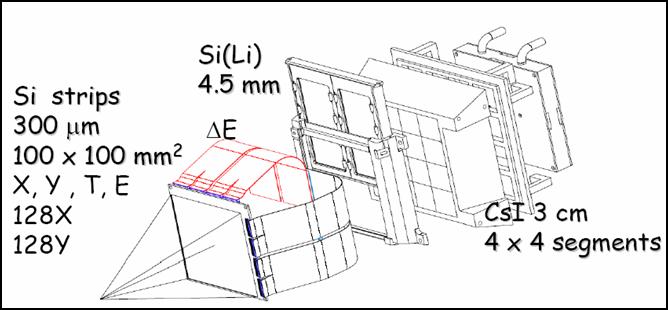Technical description
MUST2 general information and description: see TABLE

Front view of a MUST2 module (active area of the Si-strips 10 by 10cm2).
One ASIC (blue chip shown in the top right panel ) has a 6mm*6mm size, it can treat 16 multiplexed channels (preamplification, ampli, fast ampli, discriminator leading edge, TAC time signal convertor).
The reactions produced by the radioactive beams on light targets (typically proton and deuton using CH2 and CD2 targets, respectively) are measured in inverse kinematics; the light recoil charged particles (p,d,t,3,4He …) have to be identified and their characteristicshave to be measured with good resolution: we need to measure time, energy and position to reconstruct the time of flight, momentum and total kinetic energy and the trajectories. The first device developed for these measurements was the MUST (MUrs de STrips) array used since 1999 till 2004.
The goals for the MUST2 project were to develop a new device to improve the angular coverage, the granularity and resolutions compared to the previous MUST, and the objective was also to combine efficiently this n system for the particle spectroscopy with the gamma particle detection systems like EXOGAM, having clover detectors located around the reaction target. The MUST2 project has included the building of the detector, the design and realisation of its electronics and the coupling to the Data Acquisition system at GANIL.
 |
| Exploded view of the MUST2 telescope. |
Detectors The DSSD of MUST2 are produced by the MICRON society; up to now, the characteristics of these 300 µm thick doubled sided detectors correspond to the best performances in terms of active area (100 by 100 mm2) and granularity (128 strips both in horizontal and vertical positions).
ASIC Applied Specific integrated Cards for MUST2: the MATE = MUST2 Asic Time and Energy
For the MUST2 telescopes the SEDI division of IRFU has conceived a specific Integrated Card system to treat the signal of time and energy for each strip of the DSSD and for the Sili and CsI pad sectors (each SiLi or CsI detector is composed of 16 sectors, each one can give E and T signals).
Instruments MUST2 device consisted of 6 telescopes, it was extended to 8 modules in 2010 and 10 in 2013. Each module is composed of a first stage of double face Silicium-strip with 128 strips X and Y, the active area is a large square 100 cm², followed by a second stage of 4.5 mm-thick Si (Li) segmented with 2 pads of 2 x 4) with a 3cm-thick CsI [segmented CsI of 4 x 4 pads].
MUST2 can run a stand-alone mode with the Daq system software developed by GANIL DAQ group.
To reconstruct the kinematics of the light charged particles produced in the reaction studies, we need to combine the beam trajectories with the trajectories and energy measurement of the detected particles provided by the MUST2 array. The experimental set-up with MUST2 includes beam tracking detectors, needed to have the incident trajectories of he beam and to reconstruct the incident angle and impact point on the reaction target. At GANIL we use the beam tracking detector "CATS" (Chambres à Trajectoires de Saclay) these BTD provide the time of flight reference for the MUST2 telescope.
For the detection of heavy partner of the reaction, the set-up includes a spectrometer, like VAMOS or SPEG. For the combination to gamma-detection, for instance in the case of reactions like (d,pgamma), the detection system is also combined with the gamma spectrometer EXOGAM. Examples of the various experimental setups may be seen in the pages of MUST2 experiments (see the links on the Web page:http://must2.cea.fr/index.php?ref=1&id=7 ) .
MUST2 device is operated under vacuum. The compacity of the device in the reaction chamber and the reduction of the volume of the embarked electronics was obtained by the front-end ultra-compact electronics composed with ASIC cards developed by SEDI group.
VXI electronics MUVI = MUST2 VXI cards was developed in collaboration with IPNO and GANIL groups.
Data Acquisition DAQ At GANIL, the Acquisition and Electronics group has developed the special software to read the MUST2 ASICS.
Equipment The technical environment of the MUST2 telescopes (power supply, cabling for logic and anlog signals, coupling to Data Acquisition system) is entirely conditioned by the DSSD specificities.
Mechanics: the various set-ups needed for the experiments (see pictures of the various MUST2 campaigns) are designed and built by the IPNO division working on R&D for detectors and mechanics.
LINKS to coupled detection devices:
BTD: http://irfu.cea.fr/Phocea/Vie_des_labos/Ast/ast_technique.php?id_ast=791
EXOGAM, VAMOS and SPEG see detector pages on the GANIL Web site http://pro.ganil-spiral2.eu/laboratory
MUVI documentation: http://wiki.ganil.fr/gap/wiki/Documentation/VXI/MUVI

